Palm oil is the most ubiquitous edible oil on the planet. It is found in products ranging from soap, cosmetics, and cleaning products to candles, chocolate, and ice cream, and it is also used to make biofuel.
While palm oil can be defined as vegan because it contains no animal substances, the industry that produces it is by no means cruelty free.
Most palm oil production directly or indirectly harms animals. Wildlife habitat is destroyed to make way for oil palms, and animals who stray onto plantations in search of food are shot or poisoned. Deforestation makes wildlife more vulnerable to poaching.
Only a small percentage of all the palm oil on the global market is produced with zero deforestation and no violations of human rights. The term “conflict palm oil” is often used to differentiate oil that is produced at the expense of wildlife and the environment, and in a process that involves human rights violations and worker exploitation, from that produced in a responsible, sustainable manner.
- Oil palm fruit harvested in Cameroon. Image credit CIFOR, Flickr, CC BY-NC-ND 2.0
- Vat of palm oil produced in Cameroon. Image credit CIFOR, Flickr, CC BY-NC-ND 2.0
There are thousands of names for palm oil and its derivatives, such as stearic acid, cetyl alcohol, and glyceryl stearate, so it is very difficult for consumers who don’t have access to a reliable certification trademark to know whether a product contains palm oil or not. Palm oil derivatives can even be present in products that are wrongly labelled as palm oil free.
Most of the land used for oil palm cultivation was originally rainforest that was home to diverse species of wildlife, many of them endangered. Much of it had already been deforested for rubber and coconut plantations before being repurposed for growing oil palms.
Southeast Asia is the region where the most wildlife habitat has been lost to palm oil production, but conservationists are also battling to protect forest from being cleared by producers in other parts of the world.
Deforestation’s Toll on Wildlife in Borneo and Sumatra
Orangutans and elephants are two of the animals most affected by the destruction of their habitat for oil palm cultivation, and by the human-wildlife conflict that results.
Other species, including the Sumatran tiger, elephants, rhinos, sun bears, slow lorises, pangolins, various species of monkey, and many birds, insects, and reptiles, are all also hugely impacted by the clearing of forest for oil palms.
Orangutans
In 2016, the International Union for Conservation of Nature (IUCN) changed the classification of the Bornean orangutan (Pongo pygmaeus) from endangered to critically endangered, citing the main causes of its population decline as habitat loss and fragmentation, primarily for logging and oil palm plantations, along with illegal hunting and fires.
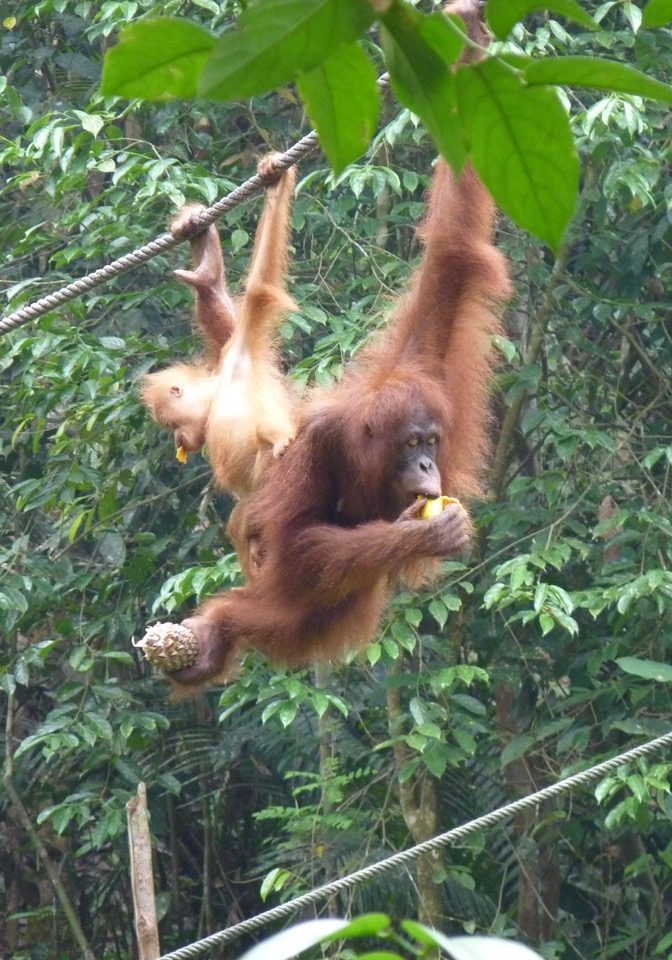
Mother and baby orangutan living semi-wild at the Semenggoh Wildlife Centre outside Kuching, Sarawak, Malaysia. Image courtesy Wolf Gordon Clifton / Animal People, Inc.
According to a United Nations report published in 2015, more than 80 percent of the remaining orangutan habitat on Borneo could be lost by the year 2080 if the island’s current land-use policies remain intact.
The report states that the massive conversion of Borneo’s forests for agricultural development – primarily oil palm plantations – will leave orangutans fragmented and facing extinction in several areas.
The Sumatran orangutan (Pongo abelii) is also listed as critically endangered.
A new species of orangutan – the Tapanuli orangutan (Pongo tapanuliensis) – was identified recently in Sumatra, but it is already being described as one of the most endangered great ape species in the world. Fewer than eight hundred of the primates remain and they are surviving in 1,100 square kilometres of remaining habitat, which is divided into three blocks of forest, separated by roads and agricultural land.
Oil palm cultivation has had an extremely damaging effect on the biodiversity of Sumatra’s Leuser Ecosystem, which is the last place on Earth where orangutans, rhinos, tigers, and elephants can be found living together in the wild.

Wild orangutan in Gunung Leuser National Park, Sumatra. Image credit Peter Nijenhuis, Flickr, CC BY-NC-ND 2.0
Panut Hadisiswoyo, who is the director of the Orangutan Information Centre, based in Medan, Sumatra, says that orangutans go to oil palm plantations in search of food. “They are looking for the forests that used to be there.”
He says rescuers often have to cut bullets out of the orangutans. “People shoot them to protect crops, to kill a mother in order to capture her baby to sell, or just for sport.”
A Bornean orangutan died in December last year after being discovered on an oil palm plantation in Central Kalimantan, Indonesia, with more than forty shotgun pellets in her body. Both of the primate’s legs and arms were broken and she was severely malnourished.
One of the orangutans being cared for at the Sumatran Orangutan Conservation Programme’s quarantine centre – a male named Leuser – was shot at least 62 times with an air rifle and was blinded by the pellets that lodged in his eyes.
It is very tragic, Hadisiswoyo says, to see orangutans in life-threatening situations because their homes have been replaced by oil palm plantations.
“Stopping the expansion of oil palm cultivation is the only way to secure a better future for orangutans and the local ecosystem.”
Devastating fires
Up to one hundred orangutans are thought to have perished in forest clearing and peat burning by palm oil companies operating in the Tripa forest, which lies within the Leuser Ecosystem. There were between 2,000 and 3,000 orangutans in the area in the 1990s, but only a few hundred remain today.

Wearing a face mask as protection against the toxic smoke from forest-clearing fires in Jambi, Sumatra. Image credit Aul Rah, Flickr, CC BY 2.0
The drying out of peatland is one of the main causes of the forest fires that have ravaged Indonesia for decades.
In 2015, massive fires devastated an area of Central Kalimantan that is home to the largest orangutan population in the world. It is impossible to know how many orangutans became sick or died in the fires, but the toll on wildlife was clearly catastrophic.
The 2015 fires were described by conservation scientist Erik Meijaard as “probably the biggest global environmental disaster of the 21st century”. They were exacerbated by the effects of the El Niño weather phenomenon, which caused a prolonged dry season in Indonesia.
In Indonesia, emissions from the 2015 fires reached 1.62 billion tonnes of CO2 – moving the country from being the sixth largest emitter in the world up to the fourth largest in just six weeks.
Researchers estimate that, on many days in September and October, the CO2 emissions from the fires exceeded the average daily emissions from all economic activity in the United States.
Elephants
In Sumatra, elephants go on to oil palm plantations because the forest land appropriated by the palm oil companies used to be their home.
Hadisiswoyo says that about 10,000 hectares of the Gunung Leuser National Park have been encroached upon for plantations.

Baby elephant crosses a road in Borneo. Image credit Col Ford and Natasha de Vere, Flickr, CC BY 2.0
“This disturbs the elephants’ movement and they get lost. They see the area as their home range and will go there no matter what.”
In April this year, a female elephant, aged about 12, was found dead on an oil palm plantation in North Sumatra, owned by the Indonesian company PT Perkebunan Inti Sawit Subur and adjacent to the Gunung Leuser National Park.
Hadisiswoyo says he warned the palm oil company in December last year that they needed to take action to prevent human-wildlife conflict as elephants were roaming near to the plantation.
In November last year, an infant elephant was severely injured in a snare on the PT Perkebunan Inti Sawit Subur plantation, and two other elephants were injured by snares earlier in the year.
“The snares on the plantation are huge,” Hadisiswoyo said. “They are clearly intended to catch mammals.”
It is suspected that the elephant found dead in April, who was discovered half submerged in a river, was poisoned, but there is insufficient evidence to indicate the cause of death.
In many cases, elephants have been poisoned by fruit laced with cyanide.
Of the fifty elephants found dead in Aceh and North Sumatra in the past four years, the majority were found on oil palm plantations.

Illegal logging in Sumatra. Image credit CIFOR, Flickr, CC BY-NC-ND 2.0
In February this year, the Rainforest Action Network (RAN) published evidence of illegal clearance of critically endangered Sumatran elephant habitat within the Leuser Ecosystem, by the palm oil company PT Agra Bumi Niaga (PT ABN).
This, RAN said, was in clear violation of the moratorium on all forest clearance for oil palm cultivation that was announced by Indonesia’s president, Joko Widodo, in April 2016.
In May 2017, Widodo approved a two-year extension to a moratorium on the issuing of new licences for plantations on primary forest and peatland.
In November, RAN reported that the company PT Tualang Raya was, in September this year, still clearing lowland rainforests inside the Leuser Ecosystem.
“Ancient elephant migratory paths run through this region and are being disrupted by palm oil expansion,” RAN said.
Elephant herds rely on the migratory paths to find food and water. When the paths are destroyed, the animals often stray onto cleared lands and come into direct contact with communities and plantation workers, increasing human-elephant conflict.
“If these key lowland rainforests continue to be destroyed, we will lose sufficient, viable habitat needed for the survival of this critically endangered species,” RAN said.

Sumatran elephants. Image credit Vincent Pouilissen, Flickr, CC BY-SA 2.0
Palm Oil Production Expanding Worldwide
Most palm oil is produced in Indonesia and Malaysia, but new frontiers are emerging in Papua New Guinea, Latin America, and Africa.
Papua New Guinea
Papua New Guinea, where there are reported to be at least two hundred species of mammals, including possums, wallabies, and the endangered tree kangaroo, and more than seven hundred bird species, is also considered to be ripe for further exploitation.
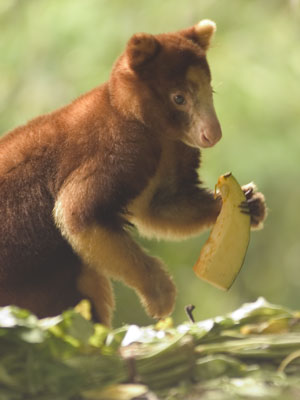
Tree kangaroo in Papua New Guinea. Image credit Nomad Tales, CC BY-NC-ND 2.0
New species are being discovered in Papua New Guinea all the time, and conservationists are a long way from knowing how many rat and frog species, as well as plants, there are in the country. They are not even sure whether all the large mammal species have been described.
In Papua New Guinea in 2014, the IUCN listed twenty species as critically endangered, 42 as endangered, 257 as vulnerable, and 251 as near threatened. The IUCN changed the listing of the Goldie’s bird of paradise, the leatherback turtle, and the vulturine parrot to vulnerable.
The critically endangered species include the black-spotted cuscus and other marsupials, one echidna species, three bat species, and several species of rodents.
The director of Eco Custodian Advocates in Papua New Guinea, David Mitchell, says we should not just be focusing on numbers. “The uniqueness, the evolutionary distinctness, and the mosaic of ecosystems that exist in Papua New Guinea and associated islands is what is important: the fabric of life, the tapestry that is becoming threadbare.”
Mitchell says that monoculture crops such as oil palm are poor in supporting species. “It is a bland ecosystem. Big swathes of these crops also act as barriers to the movement of species across the landscape. They are intensive to harvest – wheat and corn by machinery and, in the case of oil palm, it is all harvested and taken to roadside collection points.
“In Papua New Guinea this is done in backbreaking wheelbarrows by long-line labourers. Palm oil is a cheap oil we can’t afford to have.”
Africa
In West Africa, environmentalists have been battling to stop one of the world’s biggest traders of agricultural commodities – the Singapore-based company Olam International – from bulldozing rainforest in Gabon, which is home to gorillas, chimpanzees, bonobos, giraffes, elephants, and the West African manatee, to make way for oil palms.

Palm oil deforestation in Nigeria. Image credit jbdodane, Flickr, CC BY-NC 2.0
After a meeting with the global environmental campaigning organisation Mighty Earth, Olam agreed in February this year to suspend forest clearing for oil palm and rubber plantations in Gabon for a year, and said that the suspension period could be extended.
Mighty Earth, which, in 2016, produced a report entitled “Palm Oil’s Black Box”, agreed to suspend its campaign against Olam’s oil palm and rubber operations for a year.
Liberia and Cameroon are two other African countries that are attracting overseas investment in palm oil production.
Latin America
In a report about commercial oil palm expansion in Latin America, published in February this year, Paul Richard Furumo and T. Mitchell Aide from the University of Puerto Rico say that palm oil output has doubled since 2001. Most of the expansion appears to be occurring on non-forested lands, although research shows that 21 percent of plantations are on land classified as “woody vegetation”, most notably in the Amazon and the Petén region in northern Guatemala.
In the Peruvian Amazon, large areas that used to be primary forest are now planted with oil palms.
In a report published in the journal PLOS ONE in July last year, Varsha Vijay et al said that, despite having relatively small plantation areas, countries in Latin America and Africa experienced a greater percentage growth in palm oil cultivation between 2003 and 2013 than Indonesia or Malaysia.
If these growth rates continue, the authors say, it is likely that oil palm plantation expansion in these countries will have increased impacts.
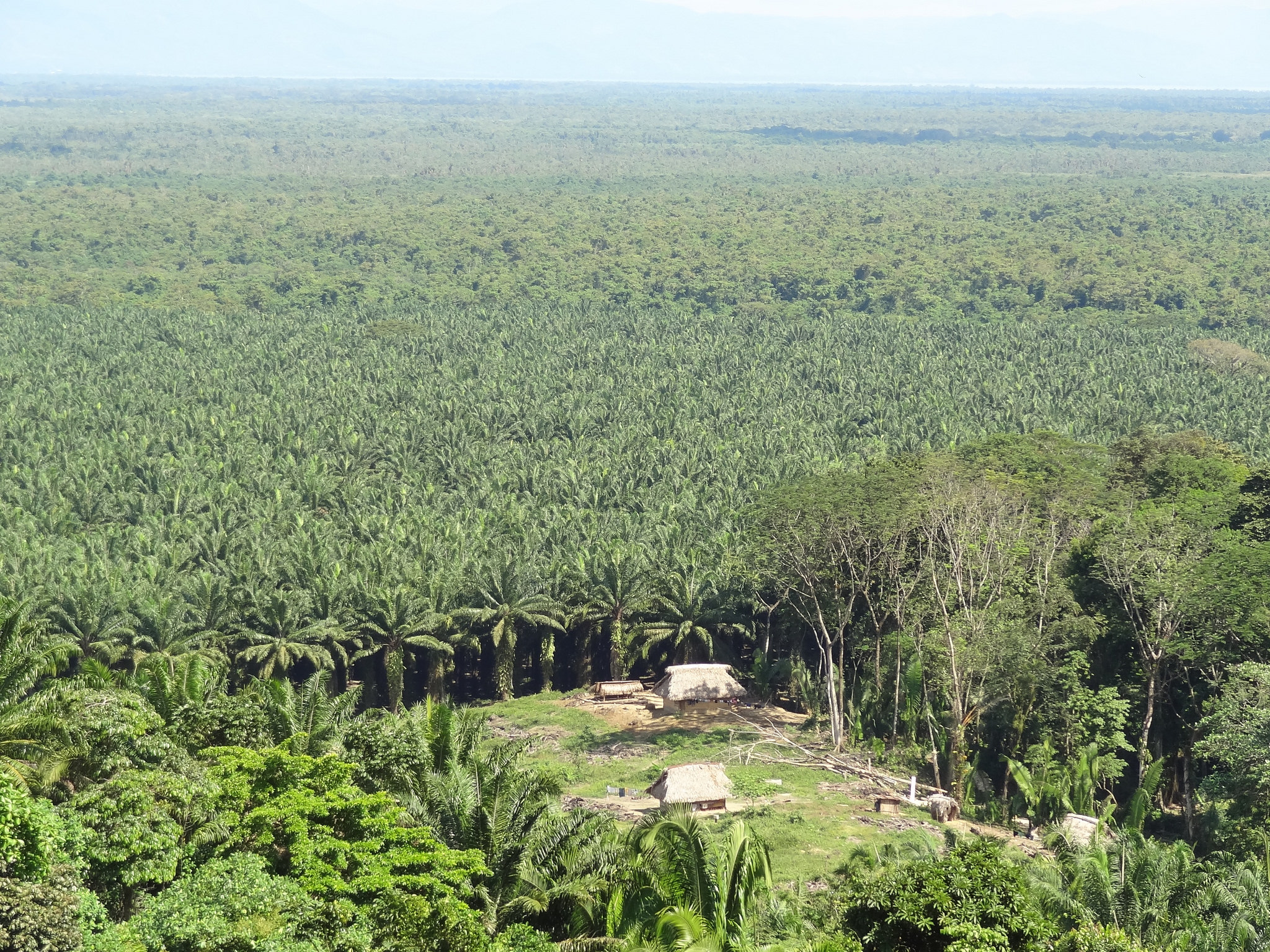
Natural forest gives way to monoculture in Peru. Image credit Climate Alliance org, CC BY-NC 2.0
Palm Oil Free and Sustainable Palm Oil Certification
In August this year, the world’s first palm oil free certification trademark was launched in Australia.
Companies can now apply to the Palm Oil Free Certification Accreditation Programme (POFCAP), which is approved to certify in Australia, the United Kingdom, Spain, and Austria, and has applications pending in 12 other countries.
To be certified by the POFCAP, products must be free not only of palm oil, but also of palm oil derivatives. The programme audits and certifies products using strict international criteria and standards.
POFCAP certifies individual products rather than brands, so companies that manufacture products containing palm oil along with products that are palm oil free can apply for certification for the palm oil free products within their range.
The POFCAP spokeswoman, Bev Luff, says that protecting the world’s rainforests requires a multi-pronged approach. She points out that palm oil is just a plant crop. “It is the production method of 83 percent of the industry that is questionable.”
Luff says that palm oil is a vegan ingredient in the sense that it is plant based and not of animal origin, “but millions of animals and insects – whole ecosystems, in fact – are wiped out because of the production of conflict palm oil.”
She points out that most consumers of palm oil live in developing countries, where people don’t usually have the luxury of choosing which oil they use, either because there are no choices and/or poverty makes the choice for them.
“I am lucky that I have the luxury of choice, so I choose a palm oil free lifestyle, but, for the millions of people in developing countries who will never even know why they should boycott palm oil, or aren’t able to, I choose to lobby companies to switch to using palm oil that has caused no deforestation on their behalf.”
Luff says the palm oil industry should be encouraged to produce non-conflict palm oil, but this is a “mammoth task that will take time”.
The executive director of the UK-based charity, the Orangutan Land Trust (OLT), Michelle Desilets, encourages consumers to contact the customer services departments of companies that use palm oil and insist that they source deforestation-free Certified Sustainable Palm Oil (CSPO).
“This is what will really make a difference on the ground,” Desilets said. “People need to send emails, or Tweet, or post comments on Facebook.
“Given the global ubiquity of palm oil, it’s pushing the industry to stop their unsustainable practices that will save animal lives and rainforests.”
Panut Hadisiswoyo also urges consumers to pressure the palm oil industry to operate responsibly, rather than simply boycotting the product indiscriminately.
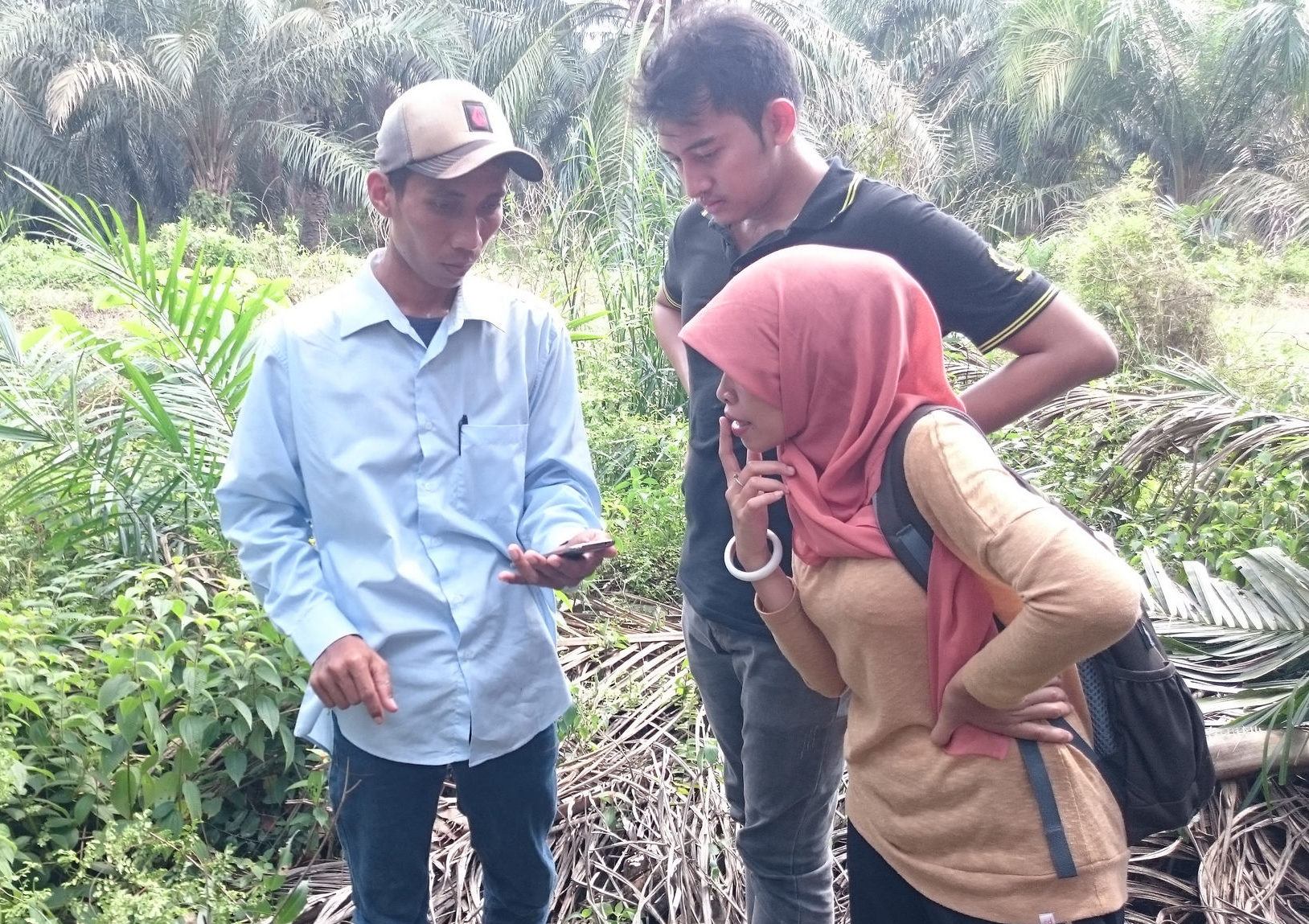
Consulting firm Prosympac conducts job training at an RSPO-certified palm oil plantation in Jambi, Sumatra. Image credit Aul Rah, Flickr, CC BY 2.0 / cropped
“It is the choice of each individual to take the action he or she wishes, but boycotting palm oil is not the way to end the destruction.
“Pressuring the industry to produce palm oil responsibly will regulate the way palm oil is produced. Boycotting will not do this. The industry will still sell to other consumers who do not care about sustainability.”
Hadisiswoyo believes that consumers have the power to push the industry to stop expanding and to implement zero-deforestation practices.
The Orangutan Land Trust is a member of the Roundtable on Sustainable Palm Oil (RSPO), which has many critics who say that it is toothless and that its certification process is seriously flawed.
Desilets says she totally understands those who choose to forgo all palm oil, including that certified by the RSPO, but considers the roundtable to be “an absolutely essential platform for transformation of the industry”.
The pressure from consumers demanding sustainability has a strong knock-on effect all the way up the supply chain to the producer and to the delivery of a sustainable product globally, Desilets says.
The OLT spearheads the PONGO (Palm Oil and NGO) Alliance, which aims to protect orangutan habitat in an oil palm landscape.
Desilets says that 10,000 orangutans are living in areas that have been identified for industrial oil palm cultivation in Borneo. “There is an urgent need for collaborative innovation to protect these animals in mixed-use landscapes.”
The CEO of International Animal Rescue, Alan Knight, points to the complexity of the palm oil debate. “While we would like to be able to encourage people to opt for sustainable palm oil, experience tells us that there is currently no guarantee that palm oil labelled as ‘sustainable’ meets the criteria to merit that description.
“We are aware of instances where orangutans have been captured and even killed on plantations belonging to palm oil companies that are members of the RSPO.”

Protest held by Friends of the Earth Indonesia outside an RSPO meeting in Bali, Indonesia, in 2008. Image credit Rainforest Action Network, Flickr, CC BY-NC 2.0
In August last year, the RSPO was fiercely criticised by NGOs and others concerned about environmental protection and human rights when it decided to reinstate its certification of the Malaysian company IOI despite there being clear evidence that the IOI group had engaged in illegal land clearance, including on peatland, and illegal planting.
The Swiss-based PanEco Foundation, which runs the Sumatran Orangutan Conservation Programme (SOCP), resigned from the roundtable, citing, among other things, what it called a “sheer level of inaction” in addressing complaints against errant members.
Desilets says, however, that even with its faults, the RSPO is “significantly superior to business as usual”.
While it is imperative to protect and restore precious wildlife habitat and sanction oil palm growers who are clearing forests illegally, the argument for pressuring companies to produce palm oil more responsibly, rather than replacing oil palms with another crop, is very strong.
Desilets points out that other vegetable oil crops have significantly lower yields than oil palms.
Calen May-Tobin from the Union of Concerned Scientists says oil palms store more carbon than any other vegetable oil crop and the typical rotation for an oil palm plantation is 25 years. “To replace all palm oil on the global market with another oil would take up between five and eight times as much land,” he said.
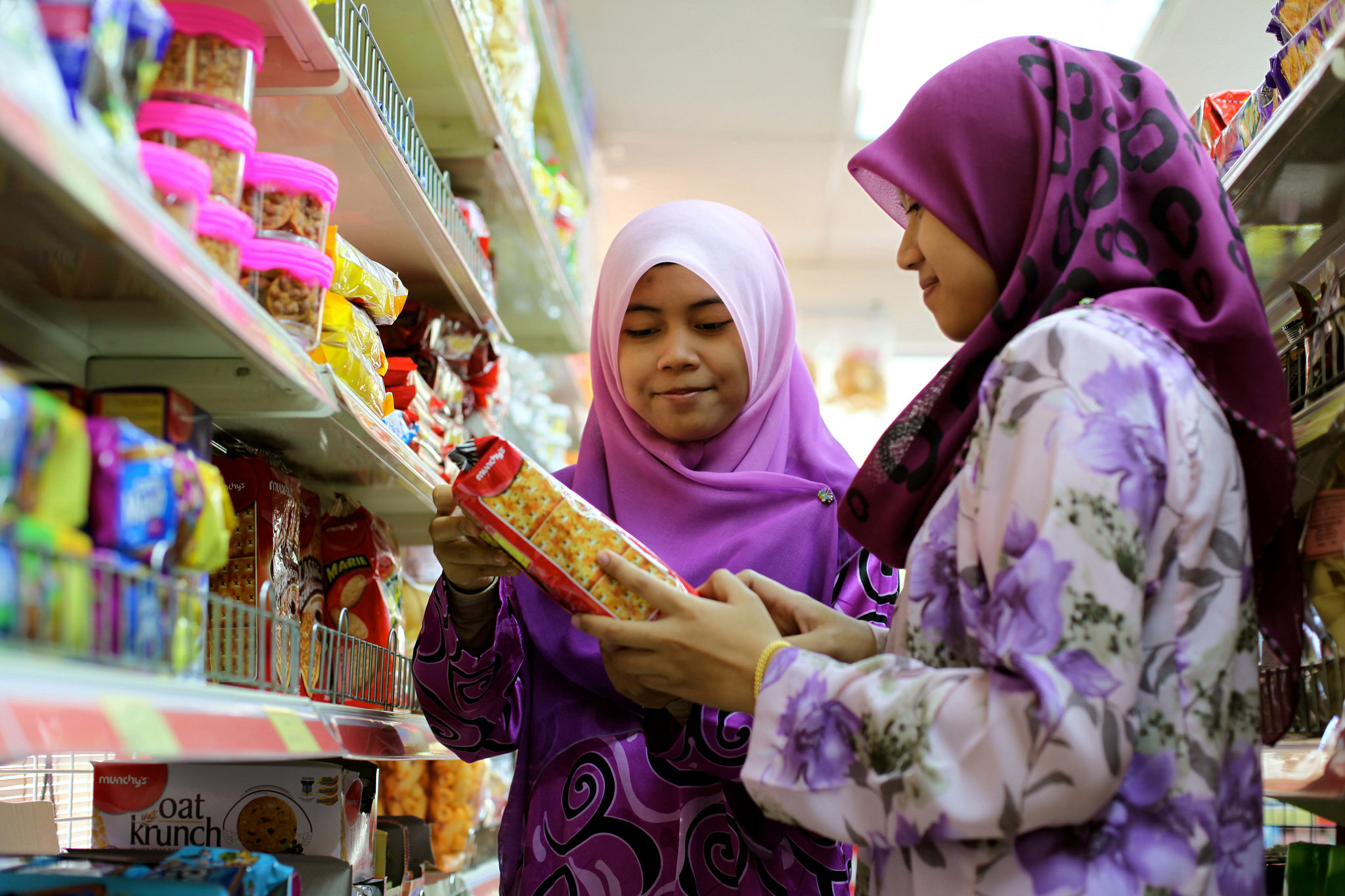
Reading ingredients and avoiding processed foods are easy ways to reduce palm oil usage. Image credit World Bank Photo Collection, Flickr, CC BY-NC-ND 2.0
What You Can Do
To help combat the devastation caused by conflict palm oil, start by reconsidering your own shopping and consumption habits.
If you wish to go palm oil free, and are in Australia, the UK, Spain, or Austria, you can choose products with the Palm Oil Free Certification Accreditation Programme (POFCAP) trademark. Keep an eye on the POFCAP website to keep up to date about the products that have been certified as palm oil free, as well as future expansion of the programme into additional countries.
Otherwise, study your labels and the many names given to palm oil (see list here) and reduce the number of products you buy that contain these ingredients. You can easily limit your use of products containing palm oil by using simple substances like bicarb and vinegar for cleaning and handmade soap from small manufacturers, and by refraining from buying processed foods.
If you are purchasing products that do contain palm oil, only buy from companies that use Certified Sustainable Palm Oil (CSPO).
There are a number of apps available that can assist you in eliminating conflict palm oil from your life, or enable you to reduce it as much as possible:
- The PalmSmart App states whether a product contains palm oil or a palm oil derivative, and details the manufacturer’s palm oil policy. Each company is graded according to its commitment to using only palm oil that is produced without causing deforestation. (Consumers using this app need to be cautious about products stated to be palm oil free as they may still contain palm oil derivatives.)
- There is also an RSPO Trademark App, which consumers can use to access a list of RSPO-certified products and share product information.
- Cheyenne Mountain Zoo in the US has a shopping app that indicates whether the palm oil in products is RSPO-certified. The zoo also has a Palm Oil Toolkit and monthly newsletters about palm oil on its website.
- Chester Zoo in the UK has a “Sustainable Palm Oil Shopping List” in the Act for Wildlife section of its website.
You can also help on a larger scale to change the way palm oil is produced and ensure protection for forests and the animals who depend on them.
Support campaigns for the mandatory labelling of palm oil in food products. (The European Union, the United States, and Canada already require palm oil to be specifically identified, but Australia and New Zealand are lagging behind.)
Contact the customer services departments of companies that are still using uncertified oil and insist that they source deforestation-free, segregated CSPO. You can put pressure on companies via social media and by telephoning them and emailing. Keep yourself informed so that you can cite accurate facts and figures.
Help to raise awareness within your social circles about the deforestation caused by palm oil production and the destruction of wildlife habitat.
Support campaigns like #LoveTheLeuser, which seeks to protect Sumatra’s Leuser Ecosystem against further industry encroachment.
Support NGOs working to rescue wildlife and protect and restore their habitat. You can volunteer, donate, or simply spread the word.
Sign petitions against the production and use of conflict palm oil.
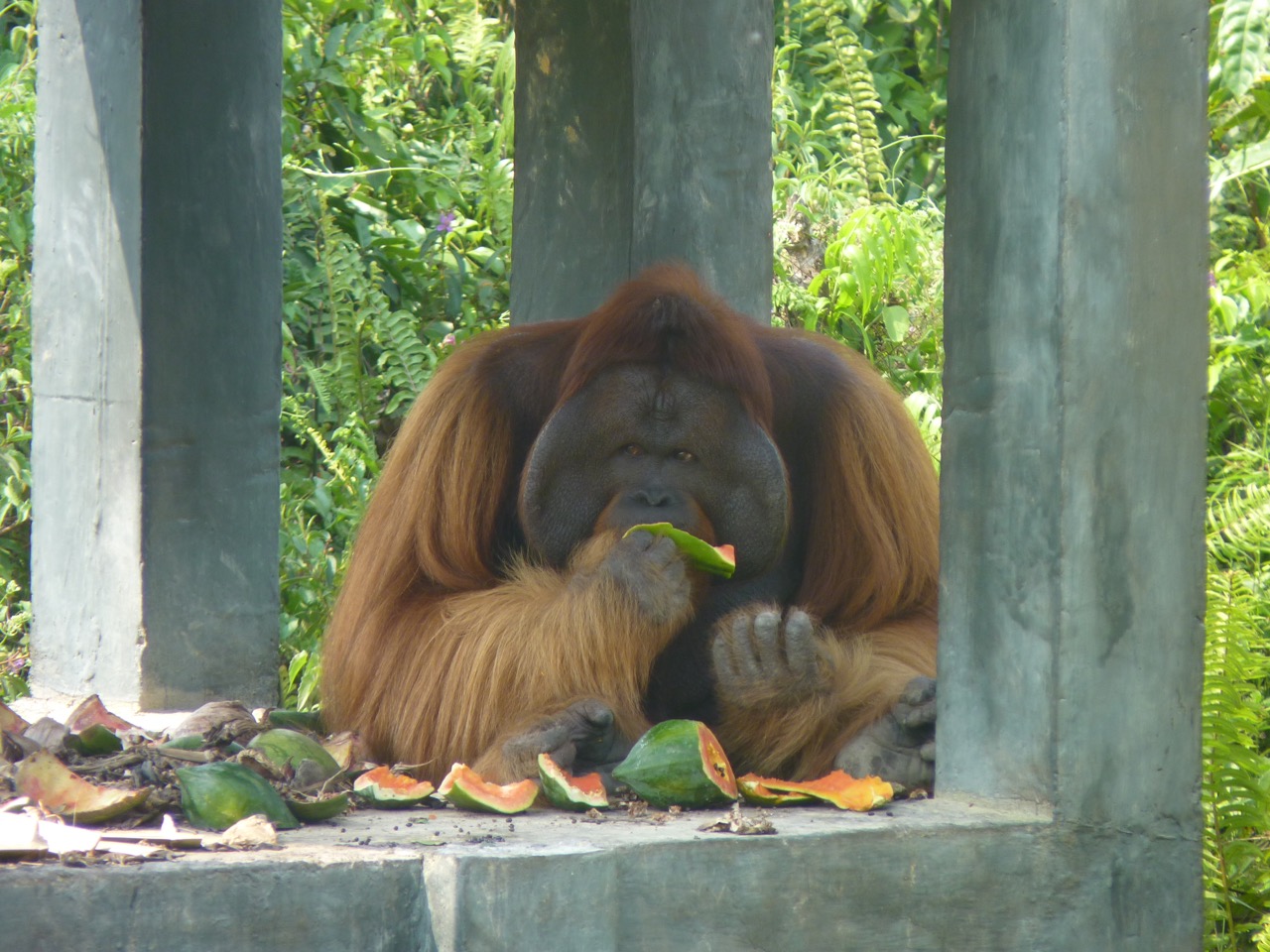
Male Bornean orangutan at Samboja Lestari, a reforestation, wildlife rehabilitation, and ecotourism project operated by the Borneo Orangutan Survival Foundation outside Balikpapan, East Kalimantan, Indonesia. Image courtesy Wolf Gordon Clifton / Animal People, Inc.
Palm Oil Facts and Figures
Palm Oil Production
- Palm oil is the most widely produced vegetable oil in the world. It has the highest yield of any oil crop, and is the cheapest vegetable oil to produce and refine.
- Oil palms are grown in 43 countries and the plantations are estimated to cover about 27 million hectares worldwide.
- Worldwide palm oil supply and distribution totalled about 58.8 million tonnes in 2015/2016, and looks set to reach more than 62 million tonnes this year. According to the United States Department of Agriculture, it is predicted to increase to 66.87 million tonnes between November 2017 and November 2018.
- More than 85 per cent of the world’s palm oil is produced in Indonesia and Malaysia.
- In 2016, Indonesia produced 36 million tonnes and Malaysia produced 21 million tonnes.
- It is estimated that half of the packaged products on supermarket shelves in the United States contain palm oil.
- There are four types of Certified Sustainable Palm Oil: Identity Preserved (IP), Segregated, Mass Balance, and Book & Claim. IP oil is from a single certified source and Segregated is from different certified sources. Both are kept separately from ordinary palm oil throughout the supply chain. Mass Balance oil is from certified sources, but is mixed with ordinary palm oil in the supply chain. Under the Book & Claim system, manufacturers and retailers buy credits from RSPO-certified growers and crushers and independent smallholders.
Deforestation
- According to the Centre for International Forestry Research (CIFOR), more than 100,000 hectares of peatland forests are destroyed each year for oil palm cultivation and other agricultural plantations.
- Based on a sample of 342,032 hectares of oil palm plantations across Latin America, the researchers found that 79 percent replaced “previously intervened lands” such as pastures and croplands and banana plantations, and primarily cattle pastures. The remaining 21 percent of plantations were on land that was classified as woody vegetation, most notably in the Amazon and the Petén region in northern Guatemala.
- In 2014, one palm oil company, PT Kallista Alam, was found guilty of illegally burning large swathes of the Tripa peat forest in 2012. The company burned about 1,000 hectares of an area that was home to the highest density of orangutans on the planet. Kallista Alam was fined 114.3 billion rupiah (at that time nearly 9.4 million US$) in compensation and 251.7 billion rupiah (then close to 20.8 million US$) to restore the affected forest, but has still not paid the money.
Impact on Wildlife
- In a report published in July this year, the International Institute for Environmental Development (IIED) says the development of large-scale oil palm plantations is responsible for “significant loss and degradation of orangutan habitat on Borneo”.
- According to the latest estimates, there were about 14,600 Sumatran orangutans left in the wild in 2015.
- There are estimated to be between 55,000 and 62,000 Bornean orangutans living in the wild, split into three distinct subspecies.
- According to the International Union for Conservation of Nature (IUCN), if the rate of decline observed since 1985, and predicted, continues unabated, the decline in the Sumatran orangutan population will exceed 80 percent over a three-generation period (i.e. 75 years from 1985 to 2060).
- The IUCN has classified the Sumatran elephant as “critically endangered”. There are estimated to be between 2,400 and 2,800 of the animals remaining in the wild – a 50 percent drop in numbers since 1985.
- The WWF says Sumatran elephants face extinction in less than thirty years unless the destruction of their habitat is halted.
Fires and CO2 Emissions
- Global Forest Watch Fires detected more than 127,000 fires across Indonesia in 2015. This was more than in any year since 1997.
- A total of 1.7 million hectares of forests and plantations were razed by fires in Sumatra and Kalimantan in 2015, according to government data.
- In Indonesia, emissions from the 2015 fires reached 1.62 billion tonnes of CO2 – moving the country from being the sixth largest emitter in the world up to the fourth largest in just six weeks.
- Researchers estimate that, on many days in September and October, the CO2 emissions from the fires exceeded the average daily emissions from all economic activity in the United States.
Featured image: mother and daughter orangutans Suci and Sri, rescued from hunters on land cleared for palm oil production. Credit Borneo Orangutan Survival Foundation, used with permission. Read the full story of their rescue here.

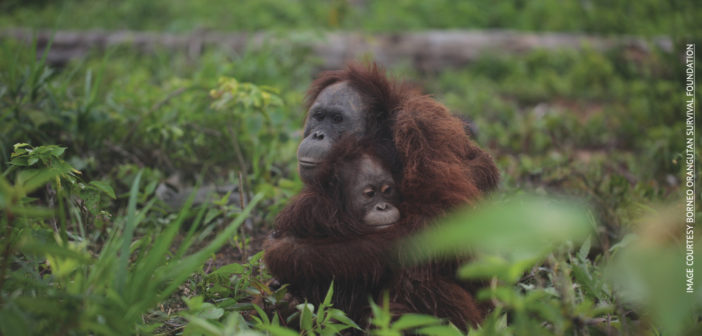
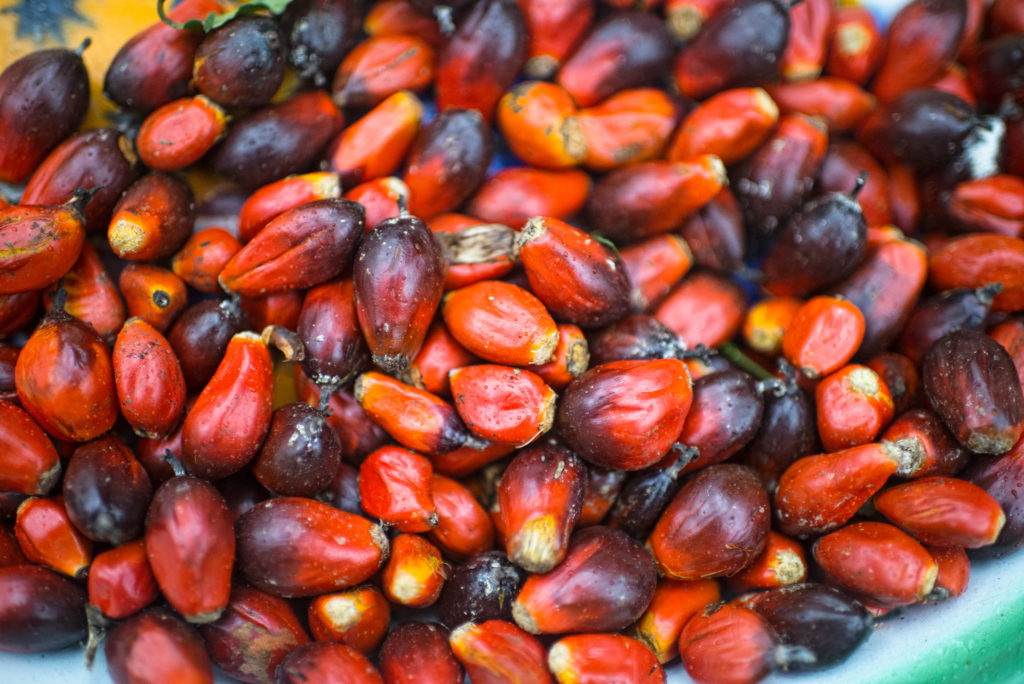

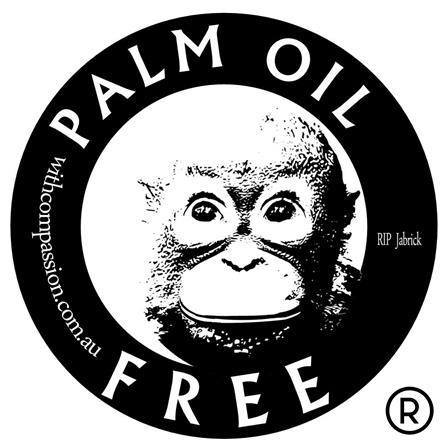




3 Comments
In many cases, elephants have been poisoned by fruit laced with cyanide.
For school we’re doing persuasive writing and mine is about palm oil. Does nestle use palm oil that is not stainable? Please let me know at ilonaabbott-newland@seatoun.school.nz
i think more emphasis need to be put on the fact that palm oil is the most productive oil per km squared, so banning palm oil would be disasterous because people would just grow another type of oil for use in these products, we need to stop using products that need this type of oil in them, like processed foods.